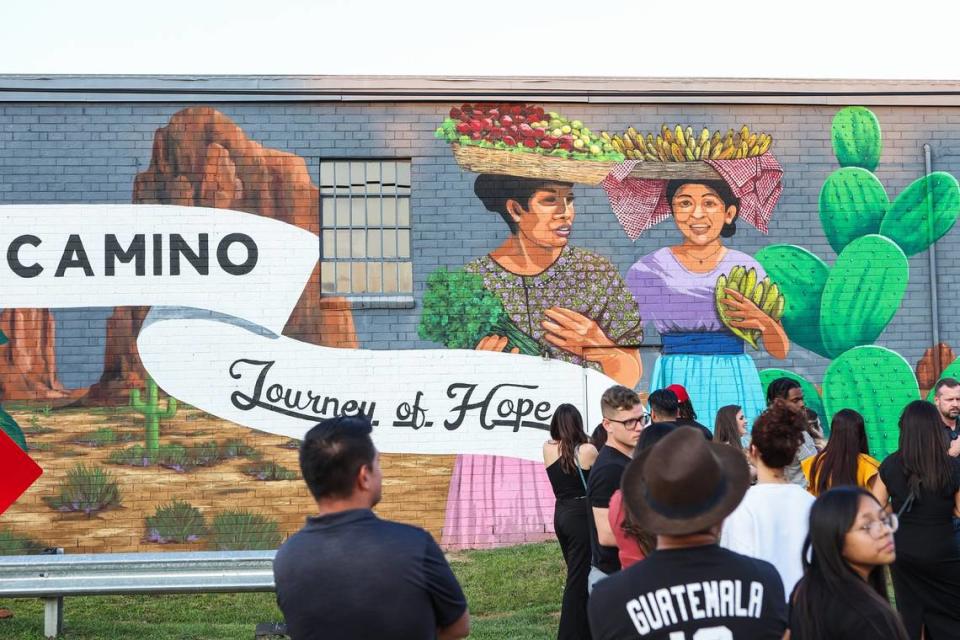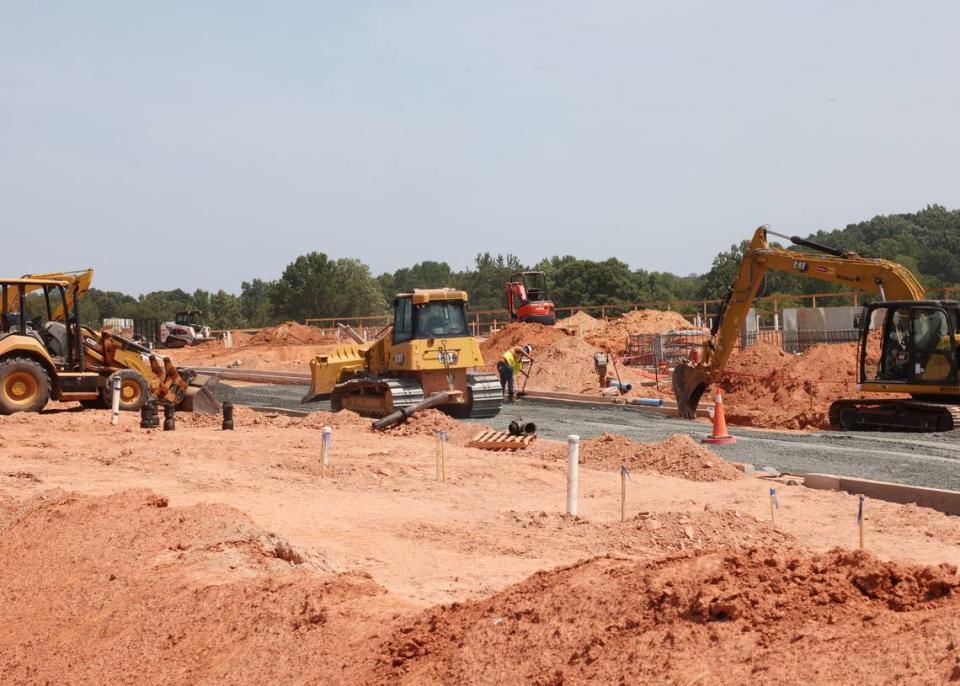In the Charlotte area, a slice of South Carolina helped boost the Hispanic growth rate
It’s no secret that Charlotte and Mecklenburg County are part of one of the fastest growing metro areas in the U.S., and recent census data continues to prove just that.
That growth is seen within the Hispanic population. Specifically, Lancaster County in South Carolina is seeing the most growth in both overall population and the Hispanic population.
Here’s what else we found:
What the numbers show
About 50,000 people became residents of Mecklenburg and its nine bordering counties between July 2022 and July 2023. They residents increased the area’s population to nearly 2.8 million people, according to the data.
That’s a growth rate of about 1.8%. About 30% of the new residents — or around 14,500 people — were Hispanic, according to a Charlotte Observer’s analysis of census data.
Within the 10-county area and yearly time frame, the Hispanic population increased by 4.3%, double the growth of the area’s Black population and about five times the rate of the white population.

This is a nationwide trend
The Hispanic population made up about 71% of overall growth in the country, mainly through what is known as a natural increase, according to a Census Bureau news release. Between 2022 and last year, the Hispanic population had about 722,000 more births than deaths.
International migration accounted for about one-third of the population’s increase, with about 437,000 newcomers entering the country.
So, why Charlotte?
It’s unclear whether the Hispanic population increase in Mecklenburg is from newcomers or a natural increase but it seems to be a bit of both, according to Michelle Zuñiga. She’s a University of North Carolina at Charlotte assistant professor in Earth, environmental and geographical sciences.
Zuñiga said the Hispanic population, and other immigrant communities, tend to move to areas where they already have a network. That could include family, friends or community members.
This way they have resources and connections to those who speak the same language and understand them on a cultural level.

Historically, Zuñiga said, those networks were in port cities such as New York City or Los Angeles. And they still are. But as those cities have become more and more expensive, the population moves away, setting up their lives in less expensive cities such as Charlotte.
Then, Zuñiga said, there’s political policy.
She said North Carolina’s political landscape toward immigrants is not as extreme as say Florida or Texas. So, North Carolina provides a halfway point for those populations moving north.
“There’s policies pushing for people to move. Stringent immigration policies have pushed individuals away from those places so that they can live a life that is less fearful,” Zuñiga said. “Perhaps North Carolina could be less fearful for them.”
There’s also resources and acceptance in cities such as Charlotte and nearby areas, Zuñiga said.
Cultural connections
Cultural festivals have increased and while there’s room for more organizations, Zuñiga said, the resources available to the Hispanic population are abundant.
Lauren Rogers, the director of community engagement for International House, agreed.
“Once they come here to Charlotte, there’s already a pretty great support system in place with the Hispanic community. A lot of times those families are able to integrate pretty seamlessly within the Hispanic network,” Rogers said.
Some of those resources include International House, Latin American Coalition and Carolina Migrant Network.
“The city of Charlotte is growing rapidly and it’s becoming more and more diverse every year,” Rogers said. “I think slowly but surely some of the service providers in Charlotte are really starting to take note and start taking steps to really be able to serve these families a little bit more efficiently.”

Booming growth rates in Lancaster County, SC
Out of the 10 area counties, Lancaster in South Carolina had both the biggest growth in total population and in its Hispanic population between 2022 and 2023. The Observer found that Lancaster’s population increased by 3.3%, while its Hispanic population jumped by 7.1%.
Zuñiga said one reason the county could be seeing a growth in the Hispanic population is for the same reason as Charlotte. The area is less expensive.
Dennis Marstall, Lancaster’s county administrator, credits the jump to the area’s quality of life, job market and affordability.
“It’s a continuation of the growth from Charlotte,” Marstall said. “But more importantly, you are finding the lower cost of living. You do find more housing options. We have a variety of jobs from manufacturing to corporate, back office jobs to tech jobs, to mortgage jobs, health care jobs…
“These things make the area attractive to everyone.”
Marstall said growth in the county is especially occurring in the northern portion such as the Indian Land area, which is closest to the North Carolina border.
In terms of affordability, Marstall said the variety in housing stock is keeping prices low. There’s a range of entry-level housing prices to executive prices. Land space is vast and also affordable, allowing for rental developments.
Between land purchases, plan submissions, county approvals and new home announcements, more than 2,500 new homes could be coming to the area, The Rock Hill Herald reported in March. The number of construction projects that have already been approved is several times higher.
“We have large developments anywhere from 15-unit housing up to 800,” Marstall said. “Having so many housing developments underway, that provides for more options and makes for a bit more competitive housing market that can be good on the price point.”
The job market is the same.
More “tech-heavy firms” are calling the area home, Marstall said, as well as existing corporate companies such as Continental Tire and Nutramax Laboratories.
Lancaster also has a heavy agriculture and timber-based economy. The range of jobs just provides new residents with more opportunities.

Infrastructure issues
As Lancaster grows, so will its infrastructure needs.
Marstall said the county is working to control growth so that the infrastructure isn’t overwhelmed, but new roadways and increases in basic public safety services are all happening now.
All of those improvements, such as highway widening, hiring more emergency personnel and creating new park systems, are in preparation for even more people.
“As the fastest growing county in the Charlotte region, we don’t see that changing in the next two or three years. We’ve got to make sure we stay focused on growth because it’s coming, whether we are ready or not,” Marstall said.
“Every department in Lancaster County has been impacted by growth,” he said. “We look forward to maintaining the quality of life for those who are here and also being an attractive place for others coming.”
Here are some other findings
▪ Lancaster County had the area’s largest percentage increase between 2022 and last year at 3.3%. Catawba County had the smallest increase at 0.9%.
▪ Two counties – Cabarrus and Gaston – saw a drop in the number of white residents.
▪ Lincoln County had the largest jump in its Black population, with an increase of 6.8%.
▪ Mecklenburg County is 44% white, 31% Black and 16% Hispanic.
NC Reality Check reflects the Charlotte Observer’s commitment to holding those in power to account, shining a light on public issues that affect our local readers and illuminating the stories that set the Charlotte area and North Carolina apart. Have a suggestion for a future story? Email realitycheck@charlotteobserver.com

